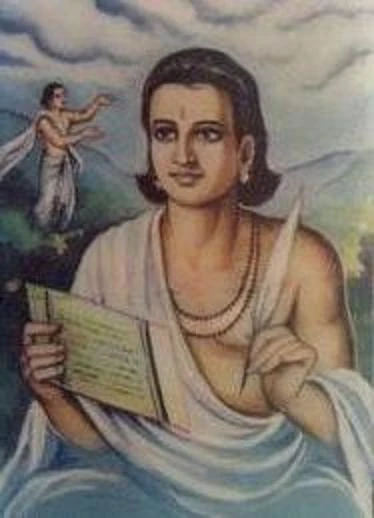Kalidas
Introduction
One of the greatest poets and dramatists in Sanskrit. His chronicle of the kings of the Raghu clan (‘Raghuvamsha’), the great play ‘Shakuntala’ and other works depict, through many great characters, the highest ideals of life as seen by the ancient people of Bharat.
A poet who has made a distinct and glorious contribution to the sumptuous Sanskrit literature is Kalidas. He has pictured in his works the beauty in life and pondered upon how we can give pleasure to others by generous and graceful behavior. His portrayals are vivid and heartwarming; his word power is unique. In a few words, he is capable of bringing out the entire meaning intended. His writings touchingly show up a noble, meaningful mode of life for the people to pursue. His works are an intellectual treat to thinkers and common readers alike.
Story of Kalidasa
A long long time ago, in India near the city of Ujjain lived a king who had a beautiful and learned daughter, Vidyottama. The princess was very proud of her learning. She would often put down the wise men in the king’s court. They started to dislike her even though they were afraid to show it outwardly. One day a group of wise men walking by the forest saw a very unusual sight. A handsome young man was sitting on the tip of one of the upper branches and trying to chop off the branch from its base. The wise men immediately agreed that this man was a great fool. This man was none other than Kalidasa. They decided to use him to take revenge on Vidyottama.
Vidyottama was of marriageable age. She had decided to only marry a man who was wiser than her. The wise men brought the marriage proposal to the king. They also mentioned that Kalidasa was a very learned man who was on a month-long maun-vrat (the vow of silence). It was considered that maun-vrat brought the purity of mind and speech and was practiced by many sages in those days. The king was impressed by the beauty of the young man and the praises from the wise men of his court. However, Vidyottama was not going to be satisfied before she tested his learning, herself. A debate was arranged where Vidyottama and Kalidasa would only communicate through gestures.
The princess raised her index finger. Kalidasa quickly replied by showing two fingers. He had thought that Vidyottama was meaning to poke him in one eye. He was obviously thinking of outdoing her. Actually, she had indicated that God is one without a second. Kalidasa’s answer was wisely interpreted as the truth has two parts the supreme God and the individual soul. She was surprised by this wisdom. Venturing further, she showed her five fingers to indicate five senses. Kalidasa thought she was about to slap him so he showed his fist. This time Vidyottama thought it to mean that controlling the five senses can lead to ultimate greatness. Thus impressed, she then agreed to marry Kalidasa.
Shortly after their marriage, one night a camel was growling outside. When the princess asked her husband “What is that?”, she expected a wise reply. But Kalidasa stammered to say the word camel in Sanskrit (ushtra). The princess understood that Kalidasa was no learned man but a fool. So she drove him out of the palace.
Heartbroken, Kalidasa was about to commit suicide. He was a devotee of Kali. He prayed to Her to grant him wisdom. With the blessings of Goddess Kali, Kalidasa was endowed with knowledge and wit. He became one of the greatest Sanskrit poets of all times (mahakavi) and one of the “nine jewels” of the court of King Vikramaditya.
Kalidas wrote seven works. ‘Kumarasambhava’ and ‘Raghuvamsha’ are his two epic poems. ‘Malavikagnimitra’, ‘Vikramorvashiya’ and ‘Abhijnana Shakuntala’ are his celebrated plays. ‘Meghaduta’ and ‘Ritusamhara’ are also poetical works of great distinction.



Comments
Post a Comment